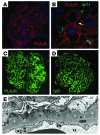Membranous nephropathy: from models to man
- PMID: 24892704
- PMCID: PMC4089468
- DOI: 10.1172/JCI72270
Membranous nephropathy: from models to man
Abstract
As recently as 2002, most cases of primary membranous nephropathy (MN), a relatively common cause of nephrotic syndrome in adults, were considered idiopathic. We now recognize that MN is an organ-specific autoimmune disease in which circulating autoantibodies bind to an intrinsic antigen on glomerular podocytes and form deposits of immune complexes in situ in the glomerular capillary walls. Here we define the clinical and pathological features of MN and describe the experimental models that enabled the discovery of the major target antigen, the M-type phospholipase A2 receptor 1 (PLA2R). We review the pathophysiology of experimental MN and compare and contrast it with the human disease. We discuss the diagnostic value of serological testing for anti-PLA2R and tissue staining for the redistributed antigen, and their utility for differentiating between primary and secondary MN, and between recurrent MN after kidney transplant and de novo MN. We end with consideration of how knowledge of the antigen might direct future therapeutic strategies.
Figures



References
-
- Kidney Disease: Improving Global Outcomes (KDIGO) Glomerulonephritis Work Group KDIGO Clinical Practice Guideline for Glomerulonephritis. Kidney Int Suppl. 2012;2(2):139–274. - PubMed
Publication types
MeSH terms
Substances
Grants and funding
LinkOut - more resources
Full Text Sources
Other Literature Sources
Research Materials

